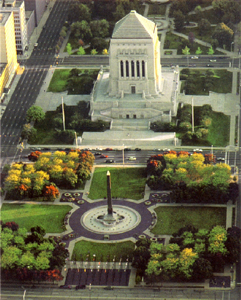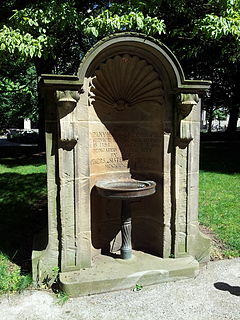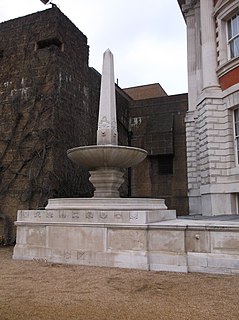
The Archibald Fountain, properly called the J. F. Archibald Memorial Fountain is located in Hyde Park, in central Sydney. It is named after J. F. Archibald, owner and editor of The Bulletin magazine, who bequeathed funds to have it built. Archibald specified that it must be designed by a French artist, both because of his great love of French culture and to commemorate the association of Australia and France in World War I. He wished Sydney to aspire to Parisian civic design and ornamentation. The artist chosen was François-Léon Sicard, who completed it in Paris in 1926 but never saw the sculpture be placed in Sydney, where it was unveiled on 14 March 1932 by the Lord Mayor of Sydney, Samuel Walder.

National Mall and Memorial Parks is an administrative unit of the National Park Service (NPS) encompassing many national memorials and other areas in Washington, D.C. Federally owned and administered parks in the capital area date back to 1790, some of the oldest in the United States. In 1933, they were transferred to the control of the National Park Service. These parks were known as the National Capital Parks from their inception until 1965. The NPS now operates multiple park groupings in the D.C. area, including National Capital Parks-East, Rock Creek Park, President's Park, and George Washington Memorial Parkway. National Mall and Memorial Parks also provides technical assistance for the United States Navy Memorial.

Littlefield Fountain is a World War I memorial monument designed by Italian-born sculptor Pompeo Coppini on the main campus of the University of Texas at Austin in Austin, Texas, at the entrance to the university's South Mall. Completed in 1933, the monument is named after university regent and benefactor George W. Littlefield, whose donation paid for its design and construction.

Armley Park,, is a large public park located next to Stanningley Road in Armley, on the outskirts of Leeds, in West Yorkshire, Northern England.

The Indiana World War Memorial Plaza is an urban feature located in Indianapolis, Indiana, United States, originally built to honor the veterans of World War I. The five-city-block plaza was conceived in 1919 as a location for the national headquarters of the American Legion and a memorial to the state's and nation's veterans. At the north end of the plaza is the American Legion Mall, which is the site of the administration buildings of the Legion, as well as a memorial cenotaph. South of that is the Veterans Memorial Plaza with its obelisk.

The Confederate Memorial Fountain in Hopkinsville, Kentucky is a monument dedicated in October 1911. It is on the National Register of Historic Places.

The El Alamein Memorial Fountain is a heritage-listed fountain and war memorial located at Macleay Street in the inner Sydney locale of Kings Cross in the City of Sydney local government area of New South Wales, Australia. It was designed by the Australian architects Robert Woodward and Phill Taranto as employed by architectural firm Woodward and Woodward. The fountain was built from 1959 to 1961. It is also known as El Alamein Fountain, Fitzroy Gardens Group, Kings Cross Fountain and King's Cross Fountain. It was added to the New South Wales State Heritage Register on 14 January 2011. The El Alamein Fountain was commissioned as a memorial to soldiers who died in 1942 during World War II in two battles at El Alamein, Egypt.

The Confederate Memorial in Mayfield is a commemorative monument and fountain located on the courthouse lawn in downtown Mayfield, Kentucky.

The Dupont Circle Fountain, formally known as the Rear Admiral Samuel Francis Dupont Memorial Fountain, is a fountain located in the center of Dupont Circle in Washington, D.C. It honors Rear Admiral Samuel Francis Du Pont, a prominent American naval officer and member of the Du Pont family. The fountain replaced a statue of Du Pont that was installed in 1884. Designed by Henry Bacon and sculpted by Daniel Chester French, the fountain was dedicated in 1921. Prominent guests at the dedication ceremony included First Lady Florence Harding, Secretary of War John W. Weeks and Secretary of the Navy Edwin Denby.

The Old Steine Gardens in Brighton, Brighton and Hove, East Sussex, England, adjacent to the Old Steine thoroughfare, are the site of several monuments of national historic significance.

Fountain for Company H, also known as Second Oregon Company Volunteers, is a 1914 fountain and war memorial designed by John H. Beaver, installed in Portland, Oregon's Plaza Blocks, in the United States. Dedicated to the men of Company H of the 2nd Oregon Volunteer Infantry Regiment killed in service during the Spanish–American War, the limestone and bronze memorial was installed in Lownsdale Square in 1914. It is part of the City of Portland and Multnomah County Public Art Collection courtesy of the Regional Arts & Culture Council. The memorial has been included in published walking tours of Portland.

The Shaftesbury Memorial Fountain, popularly but incorrectly known as "Eros", is a fountain surmounted by a winged statue of Anteros, located at the southeastern side of Piccadilly Circus in London, England. Moved after the Second World War from its original position in the centre of the circus, it was erected in 1892–93 to commemorate the philanthropic works of The 7th Earl of Shaftesbury, the Victorian politician and philanthropist, and his achievement in replacing child labour with school education. The fountain overlooks the south-west end of Shaftesbury Avenue, also named for the Earl.

The Royal Naval Division Memorial is a First World War memorial located on Horse Guards Parade in central London, and dedicated to members of the 63rd Division (RND) killed in that conflict. Sir Edwin Lutyens designed the memorial, which was unveiled on 25 April 1925—ten years to the day after the Gallipoli landings, in which the division suffered heavy casualties. Shortly after the war, former members of the division established a committee, chaired by one of their leading officers, Brigadier-General Arthur Asquith, to raise funds for a memorial. Progress was initially slow. The committee planned to incorporate its memorial into a larger monument proposed by the Royal Navy for Trafalgar Square. When the navy abandoned that project, the RND's committee decided to proceed independently. They engaged Lutyens, who, after negotiation with the Office of Works, produced a design for a fountain connected to the balustrade of the Admiralty Extension building.

Memorial Fountain is an outdoor fountain created by the architectural firm Skidmore, Owings & Merrill, located outside Veterans Memorial Coliseum in Portland, Oregon, United States.

The war memorial at British Medical Association House, Tavistock Square, Bloomsbury, London, commemorates men and women of the medical professions from the British Empire and Commonwealth who died in the Second World War. The memorial was commissioned by the British Medical Association and designed by the sculptor James Woodford. Unveiled in 1954 by Sir John McNee, then President of the BMA, and dedicated by Geoffrey Fisher, the Archbishop of Canterbury, it became a Grade II* listed structure in 1998.















